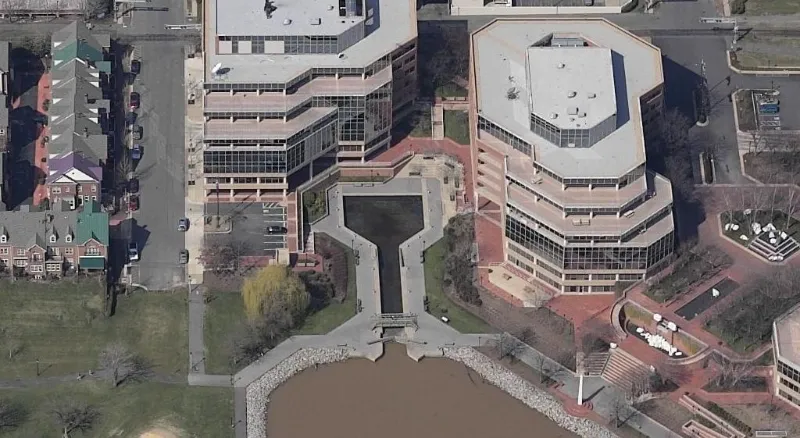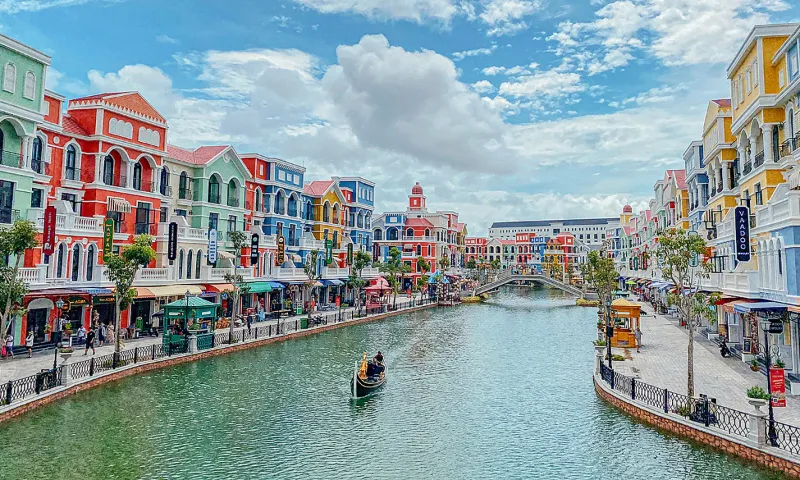Here is a mapping technique highlighting the possibility of bicycling heterotopias in just about any city. It has been designed to help people imagine greenways built along non-vehicular easements (waterways and rail corridors, for example), unlocking potential new redevelopment districts where bike-friendly building types like the one below would be the basis of a new kind of development paradigm, one that makes minimal use of machines such as lifts or motorized vehicles.
One obstacle to bicycle-oriented planning is helping people whose image of their city has been formed by years of navigating arterial roads to see the possibility of a parallel city emerging in hidden and liminal zones. I bet I could take you up in a helicopter and point out all the easements and derelict zones in your city only to have you say, “oh look; there’s the road to my house!” This mapping tool is intended to shock you into viewing your city’s non-mechanical space.

Let’s start with a city I’m sure you have been to, New York. No doubt you saw it from the side windows of taxis, or the sidewalks flanking noisy avenues that really aren’t that pleasant for cycling (even with the new bike lanes), or from the stairs leading out of that godawful chthonian subway. Well, here’s another view of New York:
Clicking on that image will take you to a large pdf version. I hope an image like this draws your attention to non-vehicular easements related to water and rail and all of the land that means little to the millions of New Yorkers who still see the place through their windscreens. This is the kind of land that cyclists like to escape to (when they’re allowed), to either save time or exposure to car fumes. When bicycle-oriented development (BOD) is accepted as a development paradigm, it will space cyclists look to build healthier and more sustainable lives for themselves and their families.
There are quite a few assumptions at play here. One is that the most practical way to a cycling utopia is not to fight car-loving voters for the land they now occupy but to recycle residual space in the city. Another is that communities of cyclists will naturally occupy a non-centric city, having employment and commerce evenly spread, yet at the same time agree on a vague epicenter for the location of meeting places and civic amenities.
In New York, the location of the oldest civic center, now called “Down Town,” was determined by the mooring location of boats in the 1600s. In the late 1800s, Grand Central Station gave rise to a new center, Midtown. The rise of cycling in New York could produce a third, very vague and nebulous epicenter around the cemeteries in Queens.

The next map of Sydney will be useful for discussing how a city’s geographical size and topography inform this mapping. Laissez-faire (anti)planning has allowed the Sydney metropolitan district to spread beyond a thousand square miles, meaning one needs to start by identifying cities within cities, in other words, bikeable regions within which cyclists’ communities can exchange goods skills without needing to commute longer than 30 minutes.
The 15km diameter sphere of interest assumes that commuting to the center from the edge will take a person riding at 15kph for around 30 minutes using linear park networks where they won’t be interrupted by cars.
The position of the circle reflects an aim to encompass four things. First, a flat region. Second, linear voids such as rail corridors, rivulets, and the edges of larger bodies of water. Third, parks. And last but not least, large lots with redevelopment potential.
The epicenter is not the harbor of maritime days or Central Station that mattered in the early twentieth century, but Alexandria Canal. Redevelopment to consolidate a population of cyclists in the area needn’t mean pushing warehousing and logistics functions to the city’s edge. My proposal (above) is for terraces in the air, served by aerial streets winding their way to the ground to encourage you always to leave your apartment by bike.

The podium level responds to the logistics function of this part of Sydney but takes logistics into the 21st century. With major profit-driven parcel companies like DHL and FedEx finding they can do their rounds in European cities faster with electric assist trikes, the time is approaching when many Sydney-based couriering companies will also switch to cycle logistics. The few minutes a pedelec trike might lose getting to the city from the new cycle logistics facility occupying the ground floor of this development would be more than made up for during their rounds since pedelec trikes have access to pedestrian areas and bike infrastructure and never lose time finding places to park right outside of their destinations.
This development opportunity was revealed through [re]cycle-space mapping. The site is within the vague epicentre of a 15km diameter portion of Sydney that is: 1. relatively flat; 2. rich in nonvehicular easements such as rail corridors and waterways that could double as bicycle highways, and 3. filled with potential for other mixed-use developments on low use industrial land.
Throughout the ages, mapping techniques have been developed that reflect the mindset and construction needs of the time. At Cycle-Space International, we thought it was high time the urban cycling renaissance had its own mapping method. It reveals at a glance the potential for bicycle-oriented redevelopment in a blighted city such as Detroit… or a smaller-scale post-industrial city, such as my home town of Newcastle, Australia… or the possibility of reconsidering the total ban on bike transport in Venice…or the scope for building new parts of Amsterdam around cycling—remembering that the old parts were built around horses.



Naturally, we welcome your comments and feedback. [Re]cycle-space maps are part of a service we offer to cities to help them start thinking about sustainable development paradigms.
Cycle Space International Pty Ltd. reserves all proprietary rights to the method described, which Dr. Steven Fleming developed with Benjamin Thorp, Charlotte Morton, Amy Pedder, and Harriet Elliot. Thanks to David Borella and Rebecca Short for the tour of Alexandria Canal and David Holowka for the Brooklyn and Queens bike tours. Thanks also to the University of Canberra for some early commissions that helped with our commercialization of this technique.

